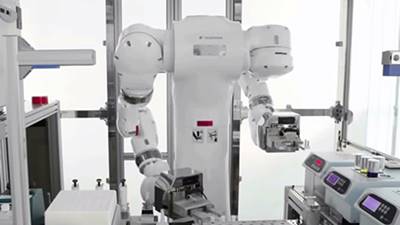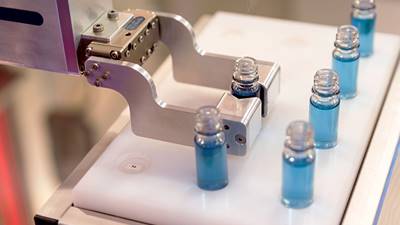Manufacturers acknowledge robotics’ ability to minimize monotonous, repetitive work and improve the work environment for operators, but it tends to come with a high price tag. Now, robotic solutions are more affordable than ever, and assembly and packaging lines are ready to reap the benefits.
In the last two decades, robotics have seen relatively stable success in specific areas. Manufacturers have integrated robots in areas such as palletizing, changing of pallets, loading and unloading of washing machines and similar heavy-duty workloads. They have tested the waters with automated guided vehicles in the material handling space as part of a full-scale automation strategy and even within end-of-line automation such as bundle, case packing casting and palletizing.
But often, companies find that utilizing robotics is not as cost efficient compared with traditional technology. This is because they often underestimate programming and intelligence, which renders less than ideal results as far as cost, robustness and reliability.
Nonetheless, two key drivers remain for the implementation of end-of-line automation – cost reduction (less operators) and the need for flexibility (many formats, long change-over on traditional equipment). That is why the last two decades has seen a limited use of robotics, particularly within pharmaceutical assembly and packaging and the need is often filled with more traditional “pick and place” or X-Y mechanical operating units and material handling units.
Pharmaceutical packaging is characterized by its variety. The many variances (formats) and many small volume batch executions are an ideal area in which to take advantage of robots.
Where is robotics heading?
The European pharmaceutical market operates approximately 25,000 packaging lines of all ages and configurations. The majority of these lines is still equipped with manual functions at end-of-line and many are on the brink of becoming technically outdated and are difficult to support and maintain. Their deterioration of efficiency and output coupled with the higher wages of the European workforce are increasing the impact on unit cost for manufacturers. Compounding this challenge is the production trends and new regulatory requirements, which beg for greater flexibility and process control.
But the hesitation in adopting robotics is changing fast. In recent years, robotics have become more cost attractive compared with traditional techniques. In addition, the robotics industry has added new improvements as well as improved intelligence. Assembly equipment suppliers are evolving and implementing robots for all material handlings instead of traditional X-Y units. Other vendors have taken a step further and developed their own original equipment manufacturer (OEM) robots for a various number of delicate process steps.
So what opportunities does robotics hold specifically for assembly and packaging today?
Assembly
Today, manufacturers utilize robots for infeed and outfeed of material to assembly processes, within, for example:
- Component sorting with camera and intelligence support
- Orientation, positioning and placement of components (i.e. springs, plastic, glass, etc.)
- Staging and buffering within and prior to processes
- Inhaler combination device assembly
In addition, it is now possible to solve other interesting assembly-related assignments with robotics, such as sampling for quality control and even core assembly of components with a high degree of format flexibility. This is possible in not only the low-speed segment, but also in the range of 600+ segment. Low speed refers to a process where line speed is less important than flexibility and is change-over-friendly. It typically requires simpler equipment than high speed. 600+ units/min is a more complex process, where robots normally can't compete in speed with more traditional techniques.
When scaling up assembly processes from clinical production to full-scale, you must justify the processes – another stage with which robots can support. Robots have a unique repeatability ingenuity, which plays an important role in smoothing the registered justification in device or drug registration filing. When robots meet assembly, perks such as repeatability, reliability and quality increase. Many industry stakeholders, from pharmaceutical manufacturers to machine suppliers, have tapped into this technological sweet spot and new solutions are emerging fast.
Packaging
Pharmaceutical packaging is characterized by its variety. The many variances (formats) and many small-volume batch executions might seem like an ideal area in which to take advantage of robots. However, the mantra of traditional machinery vendors and pharmaceutical manufacturers has been to focus on dedicated equipment and often, an overwhelming number of expensive format parts. In fact, the format parts often cost more than the core machine itself. Despite the industry clinging to tradition, we now see the utilization of robots in many traditional assignments, for example:
- Linking individual standard processes in complete packaging lines of up to 15 sub-processes or more
- Process alignment, i.e. between intermittent motion-blister process and continuous motion cartoning
- Correction and buffering between different nature processes
- Replacing traditional complex labelling equipment with robots for format flexibility and simplicity at a favourable cost – all within a low change-over timeframe
- Blisters in bulk and blisters out of bulk (BIB/BOB) concepts for bright stock and late-stage manufacturing
- In-process material staging (leaflets and cartons)
- Total end-of-line upgrade
- Aggregation failure mitigation (human factors)
- Cartridge handling
- Syringe handling
- Insulin pen packaging with “cobots”
- Pouch sorting, handling and packaging
- Complete clinical packaging processes by robots
With new, more cost effective robotics, the industry is ramping up. Suppliers of pharmaceutical packaging equipment with their own OEM robots are moving very fast in this field, subsequently pushing other suppliers to embrace robotic solutions. Though the previous decades have seen slow implementation of robotics within pharmaceutical manufacturing, all of that is about to change.


